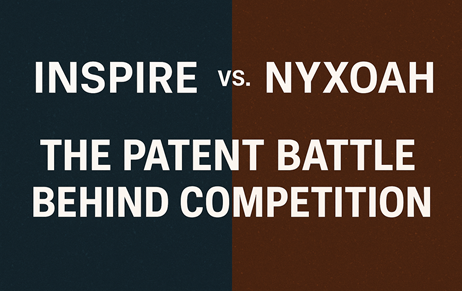BACKGROUND In May 2025, Inspire Medical Systems (Plaintiff), a market leader since 2014, filed a…
How To Proceed When Patent Applicant Dies Before And After The Grant Of Patents
When Patent applicant dies before the Patent is granted
Section 20 of the Patents Act, 1970 deals with the procedure that has to be following for substitution of applications etc.
Under S.20(4), upon the death of one or more joint applicants for a patent, the surviving applicant(s) may request the application to proceed in their name alone. However, such an application can proceed in the name of the surviving applicant (s) only once consent is given by the legal representative[1] of the deceased.
The surviving applicant should submit the request by proving the death of the joint applicant along with the consent given by the legal representative of the deceased applicant. This documentary evidence can be the certified copy of the will of deceased applicant or the letters of administration with regard to the estate of the deceased applicant. Upon this, the Controller may direct the application to proceed in the name of the survivor or survivors alone.
One must fill out Form 6 and submit it along with proof of the deceased joint applicant’s death and a certified copy of the deceased’s probate documents, such as a will or the letters of administration for his estate, or any other document proving that the person giving the consent is in fact his legal representative.
However, if any dispute arises between the joint applicants for a patent with regard to the manner in which the application should be proceeded with, the Controller may give the necessary directions to proceed upon the application submitted to him in the prescribed manner by any of the Parties, and after hearing the concerned parties.[2]
The application in this case shall be made in Form 6 in duplicate and should be accompanied by a statement that sets out the facts relied by the applicant and the directions he seeks. The Controller also sends a copy of the application and statement to every other joint applicant.
When Patent applicant dies after the Patent is granted
Section 44 of the Patents Act, 1970 deals with the amendment of patent granted to deceased applicant/ceased body corporate
Under S.44, if the patent was granted to the applicant and the Controller is satisfied that the person to whom the patent was granted died before the patent was granted, the Controller has the power to amend the patent by substituting for the name of that person with the name of the person to whom the patent ‘ought’ to have been granted.
A similar procedure is followed if a body corporate ceases to exist.
A person who wishes to submit an application to amend the patent, should submit the same in Form 10 along with substantiating evidence.
However, such a provision fails to specify “to whom the patent ought to have been granted”.
DOCUMENTS THAT PROVE SUCCESSORSHIP
PROBATE OF WILL
A probate as per the Indian Succession Act, 1925 means a copy of a Will, that is sealed by a competent court of competent jurisdiction, with a grant of administration to the estate of the testator. An executor[3] of the will can only be established in any Court when the Court has granted probate of the Will and S. 213(1) of the Hindu Succession Act, 1925 makes it mandatory for every legatee and an executor to procure a Probate of Will.
[Image Sources: Shutterstock]

How to apply for a probate?
- The executor must submit an application to the court
- The original Will needs to be attached with the application
- The executor must mention the names and addresses of the legal heirs of the deceased, in order to issue a notice to them, before the Will is probated.
- The court then requires the executor to establish the facts of the death of the testator with proof. This is generally done with the help of a death certificate
- The executor should also establish that the Will produced before the court is the last Will of the deceased and the Will was validly executed by the testator.
- Once the application is submitted and verified, notices are issues to the legal heirs of the deceased about receiving an application for probate. A general notice is also published, to raise objections to the grant of the probate
- If no objections are received, then the probate is issues
- If objections are raised, the application initiates a testamentary suit
- The cost of obtaining a probate is different is every State since the jurisdiction lies with the District Court and the fees depend on the value of assets that are considered in the petition.
SUCCESSION CERTIFICATE
Under the Indian Succession Act, a succession certificate is a document that grants the holder the power to represent the deceased in order to collect debts and securities owed to him or to be paid on his behalf. In the absence of a Will, succession certificate is the main key legal heirs use to stake a claim with regard to the assets of a deceased relative.
A succession certificate is procured by usually by applying to the magistrate or a High Court. Courts have a separate cell to issue succession certificate.
Procedure for obtaining Succession Certificate
A petition to the District judge in whose jurisdiction the deceased person ordinarily resided at the time of his or death, and the District judge jurisdiction where any part of the property of the deceased found, in case he or she did not have no fixed place of residence at the time of death.
Petition for Certificate
The following particulars need to be included in a petition for succession certificate
- Time of death of the deceased
- Residence or details of properties of the deceased at the time of death under which the District Judge jurisdiction it falls under
- Details of family or near relatives
- The rights of the petitioner
- Absence of any impediment to the grant of a certificate
Grant of Certificate
On the basis of the grounds relied to make the petition, the District Judge, if satisfied can grant an opportunity of hearing person who should be heard. Once hearing is done, the Judge decides whether succession certificate has to be granted or not. As a result of this, the Judge would issue an order granting certification to the applicant, authorizing him or her to receive interest and dividends, negotiate and transfer his or her assets, or do both.
CONCLUSION
From the above, it is clear that Section 20 of the Act deals with the procedure to be followed when a Patent Applicant dies before a patent is granted and Section 44 of the Act deals with what has to done when a patent applicant dies after the patent is granted. However, whether the legal representative is allowed to request the application to proceed in their name is unclear and it is suggested that the legal representative should also be given the opportunity to proceed the application in their name under both S.20 and S.44 of the Act. Section 2(11) of the Civil Procedural Code, 1908 states that “a legal representative is a person who is given the authority to act in charge of the person who has died and also has to act as the representative in matters of estate” and legal representative is not merely restricted to legal heirs but includes any person who have the right to inherit the property of the deceased.[6]
Furthermore, under S.44, there lies a lacuna with regard to whom the patent ‘ought’ to have been granted as there is no clarity on the same. The author is of the opinion that both S. 20 and 44 should be read with S.6 of the Act under which the legal representative of any deceased person is allowed to apply for an application because the deceased was entitled to file an application for patent, just before his death, so that the right to apply for an application also lies with the legal representative and not merely the surviving applicant (s) under S.20 or “to whom it ought to have been granted” under S.44.
Author: Liyana Shaji- a student of Symbiosis Law School (Pune), in case of any queries please contact/write back to us via email [email protected] or contact us at IIPRD.
References:
[1] Section 2(11) of Civil Procedure Code.
[2] Section 20(5), Patents Act, 1970.
[3] Section 2 (c) of the Hindu Succession Act, 1925.
[4] Kalyani Das v. Minati Das and Ors., MANU/TR/0031/2020.
[5] Marlean Wilkinson Vs. Isolyne Sarojbashini Bose and Ors., AIR1962SC1471.
[6] Custodian of Branches of Banco. v. Nalini Bai Naique, 1989 AIR 1589.



